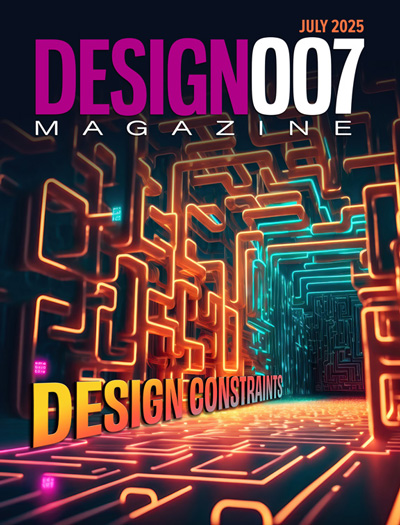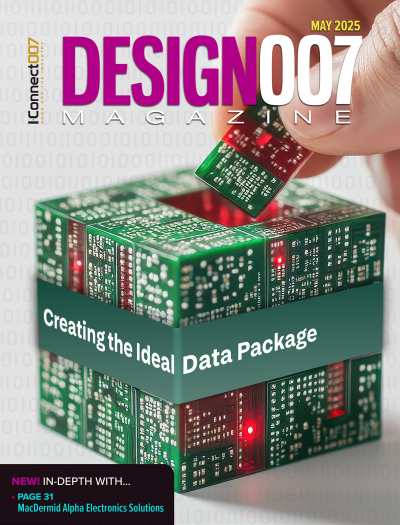-

- News
- Books
Featured Books
- design007 Magazine
Latest Issues
Current Issue
Showing Some Constraint
A strong design constraint strategy carefully balances a wide range of electrical and manufacturing trade-offs. This month, we explore the key requirements, common challenges, and best practices behind building an effective constraint strategy.

All About That Route
Most designers favor manual routing, but today's interactive autorouters may be changing designers' minds by allowing users more direct control. In this issue, our expert contributors discuss a variety of manual and autorouting strategies.

Creating the Ideal Data Package
Why is it so difficult to create the ideal data package? Many of these simple errors can be alleviated by paying attention to detail—and knowing what issues to look out for. So, this month, our experts weigh in on the best practices for creating the ideal design data package for your design.
- Articles
- Columns
- Links
- Media kit
||| MENU - design007 Magazine
Tom Hausherr Discusses PCB Libraries’ BOM Builder Service
March 15, 2017 | Kelly Dack, CID+Estimated reading time: 13 minutes
PCB Libraries CEO Tom Hausherr and Editor Kelly Dack discuss PCB Libraries’ new BOM Builder service during IPC APEX EXPO. Equipped with the new LEAP technology, the BOM Builder can potentially save PCB designers days or weeks of time normally spent turning a BOM into a CAD library.
Kelly Dack: Managing data has always been a challenge. What can be done to simplify the process? I’m speaking with Tom Hausherr, an industry expert in PCB libraries and all things data. Welcome, Tom. As far as assembly information and assembly data, what do you see as some of the challenges that designers face in organizing and implementing strategies for assembly?
Tom Hausherr: The assembly standard for solder joint acceptability is IPC-J-STD-001. The big challenge designers face is creating CAD library parts that meet this industry standard. I took the IPC CIT training class to learn about J-STD-001 and I was surprised to find out that the IPC-7351 land pattern standard did not really match up with J-STD-001 rules. PCB Libraries Inc. took the IPC-7351 and expanded the terminal lead solder joint goals into various case sizes and pin pitches. An example of this is the chip component family or “rectangular end cap” terminal lead. IPC-7351 solder joint goals for the nominal density level are 0.35 mm Toe for all chip components. But the J-STD-001 indicates that the toe solder joint acceptability be minimum 25% of the height or 0.50 mm whichever is less. This clearly indicates that the toe dimension for 01005, 0201, 0402, 0603, 0805 and 1206 should be different values and the default values must be editable by the end user to meet their specific assembly shop tolerances.
Dack: Is it typically the schematic that serves as the hub of the information for PCB layout?
Hausherr: It does, because the schematic contains all the information that derives the netlist for the routing connections and the bill of materials, which is normally in Excel spreadsheet format.
Dack: Once the information is broken out, exported or otherwise utilized for the layout, what's the next step?
Hausherr: The dilemma in the industry today, and it's been this way for decades, is that the PCB designer is handed a package of data, including the BOM spreadsheet, and they must spend time, in some cases a week, disseminating all this data from the engineer. Creating the new PCB library parts is the most time consuming process. The PCB designer will first search in the existing corporate library and isolate all new part numbers that require library creation. Then the PCB designer or CAD librarian will use the internet to search and locate the package dimensional datasheet. This is a very tedious, time-consuming process to go from bill of materials to a full-blown CAD library with 3D STEP for a specific PCB layout.
Dack: This information is a repetitive function if it's not captured at a certain point, isn’t it? Is it something that's replicated unnecessarily over and over, or are there automated ways of dealing with this?
Hausherr: Duplication of effort is rampant in the CAD library industry. There are automated ways to prevent duplication of work, but the component manufacturing industry is consistently releasing new technology to the industry at the rate of thousands of new part numbers every week. Many of these new logical device part numbers reuse the same physical package data which would use an existing footprint pattern. There are over 100 million different part numbers in the industry today. We are estimating 200 million mfr. part numbers by the year 2020. The acceleration of new component packages seems to be increasing. Trying to keep up with this massive amount of content and totally eliminate duplication is difficult. And component package obsolescence is another factor. There are parts in every CAD library that are obsolete, but they’re still maintained and rarely purged. If your CAD library is 20 years old and built by many people using different rules, it’s probably best to start the creation of a new library from scratch using modern technology and updated rules.
Dack: As a designer or an engineer, or anyone capturing the information for a particular design, it's not necessary to address all of those parts; however, what automation solution does PCB Libraries offer?
Hausherr: PCB Libraries is introducing to the electronics industry new program called the “BOM Builder Service” where designers or engineers import their Excel spreadsheet bill of material into Library Expert Pro and that creates a neutral FPX file. The customer emails the FPX file to bom@pcblibraries.com, and in as little as 10-15 minutes the FPX file is returned to the customer with the component dimensional data or the manufacturer recommended land patterns that are on our cloud server. If the BOM request contains parts that are not on our Parts on Demand (POD) server, we build the remaining standard parts for free with a 24-hour delivery. Once the designer has the component dimensions loaded into Library Expert Pro, they run the dimensional data through their personal Preferences for pad shapes, drafting items, polarity options, footprint rotation and origin, solder joint goals, density level and library rules and output to their CAD tool. The design of the resulting footprints is fully customized by the user preferences. This is totally the opposite of static CAD library parts offered by everyone else in this business space.
Page 1 of 3
Suggested Items
Silicon Mountain Contract Services Enhances SMT Capabilities with New HELLER Reflow Oven
07/17/2025 | Silicon Mountain Contract ServicesSilicon Mountain Contract Services, a leading provider of custom electronics manufacturing solutions, is proud to announce a significant upgrade to its SMT production capability with the addition of a HELLER 2043 MK5 10‑zone reflow oven to its Nampa facility.
Knocking Down the Bone Pile: Addressing End-of-life Component Solderability Issues, Part 4
07/16/2025 | Nash Bell -- Column: Knocking Down the Bone PileIn 1983, the Department of Defense identified that over 40% of military electronic system failures in the field were electrical, with approximately 50% attributed to poor solder connections. Investigations revealed that plated finishes, typically nickel or tin, were porous and non-intermetallic.
SHENMAO Strengthens Semiconductor Capabilities with Acquisition of PMTC
07/10/2025 | SHENMAOSHENMAO America, Inc. has announced the acquisition of Profound Material Technology Co., Ltd. (PMTC), a premier Taiwan-based manufacturer of high-performance solder balls for semiconductor packaging.
KYZEN to Highlight Understencil and PCB Cleaners at SMTA Querétaro Expo and Tech Forum
07/09/2025 | KYZEN'KYZEN, the global leader in innovative environmentally responsible cleaning chemistries, will exhibit at the SMTA Querétaro Expo & Tech Forum, scheduled to take place Thursday, July 24, at Centro de Congresos y Teatro Metropolitano de Querétaro.
Driving Innovation: Direct Imaging vs. Conventional Exposure
07/01/2025 | Simon Khesin -- Column: Driving InnovationMy first camera used Kodak film. I even experimented with developing photos in the bathroom, though I usually dropped the film off at a Kodak center and received the prints two weeks later, only to discover that some images were out of focus or poorly framed. Today, every smartphone contains a high-quality camera capable of producing stunning images instantly.


